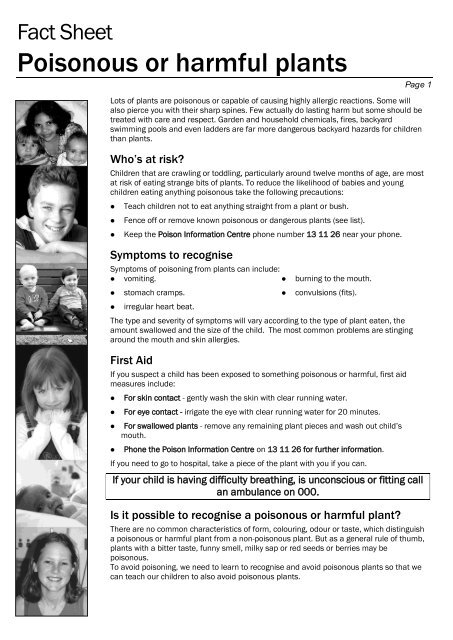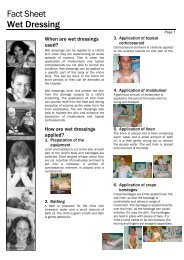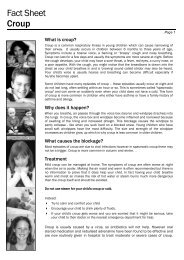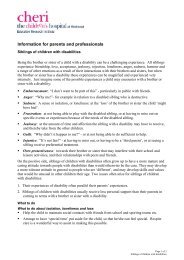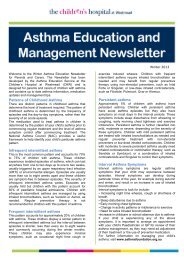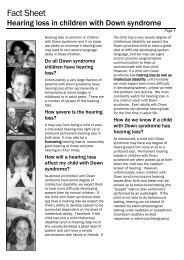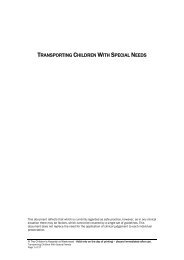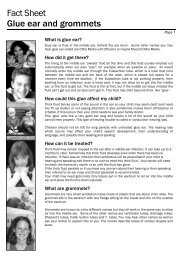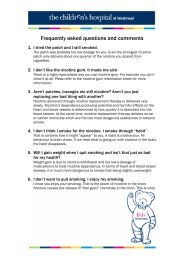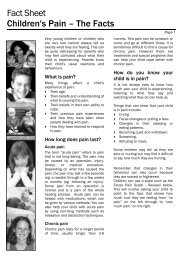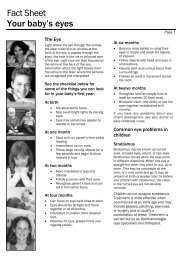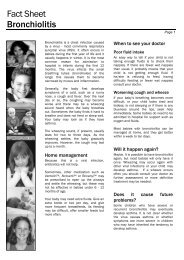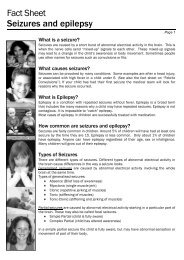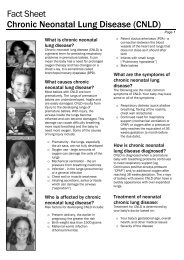Fact Sheet Poisonous Or Harmful Plants - Kids Health @ CHW
Fact Sheet Poisonous Or Harmful Plants - Kids Health @ CHW
Fact Sheet Poisonous Or Harmful Plants - Kids Health @ CHW
You also want an ePaper? Increase the reach of your titles
YUMPU automatically turns print PDFs into web optimized ePapers that Google loves.
<strong>Fact</strong> <strong>Sheet</strong><br />
<strong>Poisonous</strong> or harmful plants<br />
xcvxcvxcv<br />
Page 1<br />
Lots of plants are poisonous or capable of causing highly allergic reactions. Some will<br />
also pierce you with their sharp spines. Few actually do lasting harm but some should be<br />
treated with care and respect. Garden and household chemicals, fires, backyard<br />
swimming pools and even ladders are far more dangerous backyard hazards for children<br />
than plants.<br />
Who’s at risk?<br />
Children that are crawling or toddling, particularly around twelve months of age, are most<br />
at risk of eating strange bits of plants. To reduce the likelihood of babies and young<br />
children eating anything poisonous take the following precautions:<br />
Teach children not to eat anything straight from a plant or bush.<br />
Fence off or remove known poisonous or dangerous plants (see list).<br />
Keep the Poison Information Centre phone number 13 11 26 near your phone.<br />
Symptoms to recognise<br />
Symptoms of poisoning from plants can include:<br />
vomiting.<br />
stomach cramps.<br />
irregular heart beat.<br />
burning to the mouth.<br />
convulsions (fits).<br />
The type and severity of symptoms will vary according to the type of plant eaten, the<br />
amount swallowed and the size of the child. The most common problems are stinging<br />
around the mouth and skin allergies.<br />
First Aid<br />
If you suspect a child has been exposed to something poisonous or harmful, first aid<br />
measures include:<br />
For skin contact - gently wash the skin with clear running water.<br />
For eye contact - irrigate the eye with clear running water for 20 minutes.<br />
For swallowed plants - remove any remaining plant pieces and wash out child’s<br />
mouth.<br />
Phone the Poison Information Centre on 13 11 26 for further information.<br />
If you need to go to hospital, take a piece of the plant with you if you can.<br />
If your child is having difficulty breathing, is unconscious or fitting call<br />
an ambulance on 000.<br />
Is it possible to recognise a poisonous or harmful plant?<br />
There are no common characteristics of form, colouring, odour or taste, which distinguish<br />
a poisonous or harmful plant from a non-poisonous plant. But as a general rule of thumb,<br />
plants with a bitter taste, funny smell, milky sap or red seeds or berries may be<br />
poisonous.<br />
To avoid poisoning, we need to learn to recognise and avoid poisonous plants so that we<br />
can teach our children to also avoid poisonous plants.
<strong>Fact</strong> <strong>Sheet</strong><br />
<strong>Poisonous</strong> or harmful plants<br />
xcvxcvxcv<br />
Page 2<br />
<strong>Plants</strong> to watch out for<br />
To help you find your way through the lists of poisonous garden plants we’ve assessed<br />
their likely risk. Many plants have poisonous bulbs or roots but as these are usually<br />
safely underground, they are not likely to poison anyone.<br />
Others taste so awful that it is difficult to eat enough to cause a serious injury. Oleander,<br />
for example tastes so bitter and unpalatable that it is difficult to accidentally eat very<br />
many of the leaves.<br />
On the other hand there are plants that look appealing but contact can have bad results.<br />
See the list on plants to avoid.<br />
Categories of poisonous or dangerous plants<br />
1. Danger! Don’t plant.<br />
2. Avoid these plants if you have children.<br />
3. <strong>Poisonous</strong>, treat with caution.<br />
4. <strong>Poisonous</strong>, but not usually a concern.<br />
1. Danger! Don’t plant.<br />
These are highly poisonous or allergic plants, which shouldn’t be included in gardens.<br />
Asthma or stick weed ( Parietaria judaica)<br />
Although a weed, this plant may be associated with<br />
asthma attacks and can also cause skin allergies.<br />
Remove it from your garden and surroundings. It<br />
can be a weed of wastelands and footpaths<br />
particularly around Sydney and coastal NSW.<br />
Yellow oleander (Thevetia peruviana)<br />
Rhus (Toxicodendron succedaneum)<br />
Most people are very allergic to all parts of this<br />
plant. It is classified as weed in most areas.<br />
Don’t plant it or allow self sown plants to grow.<br />
Remove existing plants with care. Cover your<br />
hands and body to avoid contact. If you have<br />
an allergic reaction, don’t touch the tree againget<br />
someone else to remove it.<br />
All parts of this plant are toxic. Seeds are very poisonous but also highly appealing,<br />
especially, to kids, often called lucky nuts. <strong>Plants</strong> are evergreen with yellow tubular<br />
flowers. Mainly found in warm climates or coastal gardens. Yellow oleander is different to<br />
the oleander commonly found in Sydney, Australia. See the “<strong>Poisonous</strong>, treat with<br />
caution” section of this fact sheet for information on Oleander (Nerium Oleander).
<strong>Fact</strong> <strong>Sheet</strong><br />
<strong>Poisonous</strong> or harmful plants<br />
xcvxcvxcv<br />
2. Avoid these plants if you have children.<br />
Avoid handling these plants and don’t grow them where children play or in areas where<br />
you walk.<br />
Cactus and many succulents (all species<br />
with spines)<br />
Stylish but highly dangerous, especially to eyes. If<br />
you want to grow succulents, plant those without<br />
spines such as Agave attenuata.<br />
Dumb cane (Dieffenbachia)<br />
Chillies (especially hot varieties)<br />
Page 3<br />
Chillies especially the small pretty coloured forms are very<br />
attractive to children. Although eating them is unlikely to be fatal<br />
hot chillies can cause children a lot of damage and distress. If<br />
you love chillies, warn children not to touch.<br />
Is a popular indoor plant but if it is eaten it can cause the mouth to become highly<br />
irritated and swell. It will not do any permanent injury and will not affect the brain.<br />
Mushrooms and toadstools<br />
There are many highly toxic species and it is difficult to tell the difference between edible<br />
and inedible forms. Particularly dangerous are death caps (which have caused deaths in<br />
the ACT) and the attractive fly agaric (Amanita muscaria) which is red with white spots.<br />
Most of the toxic species are found in forests or among trees not in backyards.<br />
3. <strong>Poisonous</strong>, treat with caution.<br />
These plants contain poison and can be dangerous if they are eaten. Learn to recognise<br />
these plants and teach your children that they should not be eaten. If you are concerned<br />
about having them in a garden where there are babies and young children, fence them<br />
off until the children are older.<br />
Angels trumpet ( Brugmansia)<br />
All parts of the plants are toxic. The flowers can cause<br />
hallucinations and may appeal to risk-taking young<br />
people.
<strong>Fact</strong> <strong>Sheet</strong><br />
<strong>Poisonous</strong> or harmful plants<br />
Cycads<br />
The seeds are bright red and yellow and look<br />
appealing but are poisonous and should not be eaten.<br />
When used as bush tucker, the seed is carefully<br />
leached of toxins before they are ground into flour.<br />
Oleander (Nerium oleander)<br />
All parts are poisonous but taste awful. Growing<br />
them as standards keeps the leaves and<br />
flowers out of reach of children. Always wash<br />
your hands after pruning oleanders as the sap<br />
can irritate the skin and eyes.<br />
Rhubarb leaves<br />
Grevilleas (especially ‘Robyn Gordon’)<br />
Page 4<br />
Grevilleas can cause dermatitis but are rarely<br />
dangerous unless they are being pruned or propagated<br />
by cutting. Wear gloves to reduce contact.<br />
Poinsettia<br />
The sap is an irritant, so handle plants with care. The leaves<br />
and seeds can cause delirium if eaten.<br />
The stalks are edible but the leaves contain a toxin. Don’t eat the leaves and don’t feed<br />
leaves to chooks or pet birds.
<strong>Fact</strong> <strong>Sheet</strong><br />
<strong>Poisonous</strong> or harmful plants<br />
White cedar<br />
After the leaves fall from the tree, yellow seeds are left which are toxic. These trees are<br />
however fast growing shade trees which do well in northern and inland gardens.<br />
Wisteria<br />
Eating the seeds/pods can cause gastric pain and vomiting.<br />
Page 5<br />
4. <strong>Poisonous</strong> but not usually a concern.<br />
The following plants often appear on lists of poisonous plants but the poisonous part (for<br />
example the root), is usually out of sight and reach or not likely to be eaten, so don’t<br />
worry unduly.<br />
Agapanthus<br />
The underground parts are poisonous.<br />
Arum lily<br />
Amaryllis<br />
The bulbs are poisonous.<br />
All parts of the plant are poisonous, including the bulbs.<br />
Azaleas and rhododendrons<br />
Are poisonous, but only if eaten in great quantity.
<strong>Fact</strong> <strong>Sheet</strong><br />
<strong>Poisonous</strong> or harmful plants<br />
Daffodils and other narcissus<br />
The bulbs are poisonous.<br />
Lily-of-the-valley<br />
The bulbs are poisonous.<br />
Remember<br />
Foxgloves (Digitalis)<br />
Are poisonous, they contain the heart medicine digitalis.<br />
Teach children not to eat anything straight from a plant or bush.<br />
Fence off or remove known poisonous or dangerous plants (see list).<br />
Keep the <strong>Poisonous</strong> Information Centre phone number 13 11 26 near your phone.<br />
We would like to thank Jennifer Stackhouse and Burke’s Backyard for the text and<br />
Burke’s Backyard magazine (Brent Wilson and Lorna Rose) for the photos.<br />
This fact sheet is for education purposes only.<br />
Please consult with your doctor or other health professional<br />
to make sure this information is right for your child. This document was reviewed on 24 th February 2010<br />
www.chw.edu.au www.sch.edu.au<br />
© The Children’s Hospital at Westmead & Sydney Children’s Hospital, Randwick –2011<br />
Page 5


